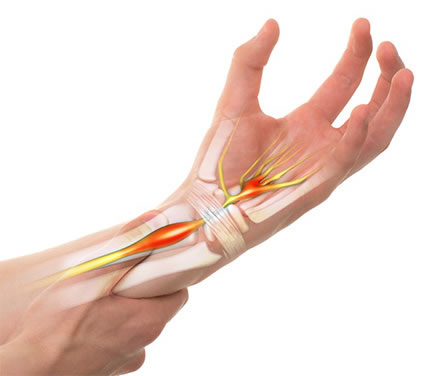
The median nerve in the wrist gets pressurized making the Carpal Tunnel smaller and thus causing pain the hand. In the forearm are present several tendons and the median nerve that run to the hand from the forearm. In the wrist is a small space called Carpal Tunnel. Feeling and movement in the first three fingers and the thumb are controlled by the median nerve.
How do you get carpal tunnel?
Causes of swelling in the Carpal Tunnel could be illnesses like diabetes, rheumatoid arthritis and hypothyroidism. Making same kind of movements in the wrist over and over again and if the wrist is bent, then swelling can occur in the Carpal Tunnel.
Symptoms of Carpal Tunnel Syndrome include weakness, numbness, tingling sensation and other problems in the hand. Some people may experience pain in the arm between the elbow and hand, in half of the ring finger, middle finger, index finger and the thumb. If the little finger has no pain then it could be an indication of Carpal Tunnel Syndrome. The little finger is given a feeling of sense by a different nerve.
Diagnosis of Carpal Tunnel Syndrome is done by the doctor with analysis about any kind of hurt to the neck, arm or wrist recently, daily routine and activities followed. Besides this the doctor also checks out appearance, strength and feeling of the hands, wrists, shoulders and neck. Nerve tests and blood tests may also be suggested by the doctor.
How do you relieve carpal tunnel?
Carpal Tunnel Syndrome treatment includes home care, stopping activities that cause pain and numbness, providing rest to the wrist between activities, applying ice for around 10 minutes once or twice every hour, wearing a wrist splint during night time. To reduce swelling and relive pain, non steroidal anti inflammatory drugs are also administered. Chances of stopping symptoms are better if treatment is given sooner and in the process, the nerve is prevented for getting damaged over the long term. If symptoms are very bad then the next option is surgery after which for several weeks to months, the patient is advised to give the wrist, complete rest. After treatment the patient is advise to take good care of hands and wrists by using whole hand for holding objects and not just finger, keeping the wrist in neutral position, switching hands while repeating movements and relaxing shoulders when arms are at the sides.








